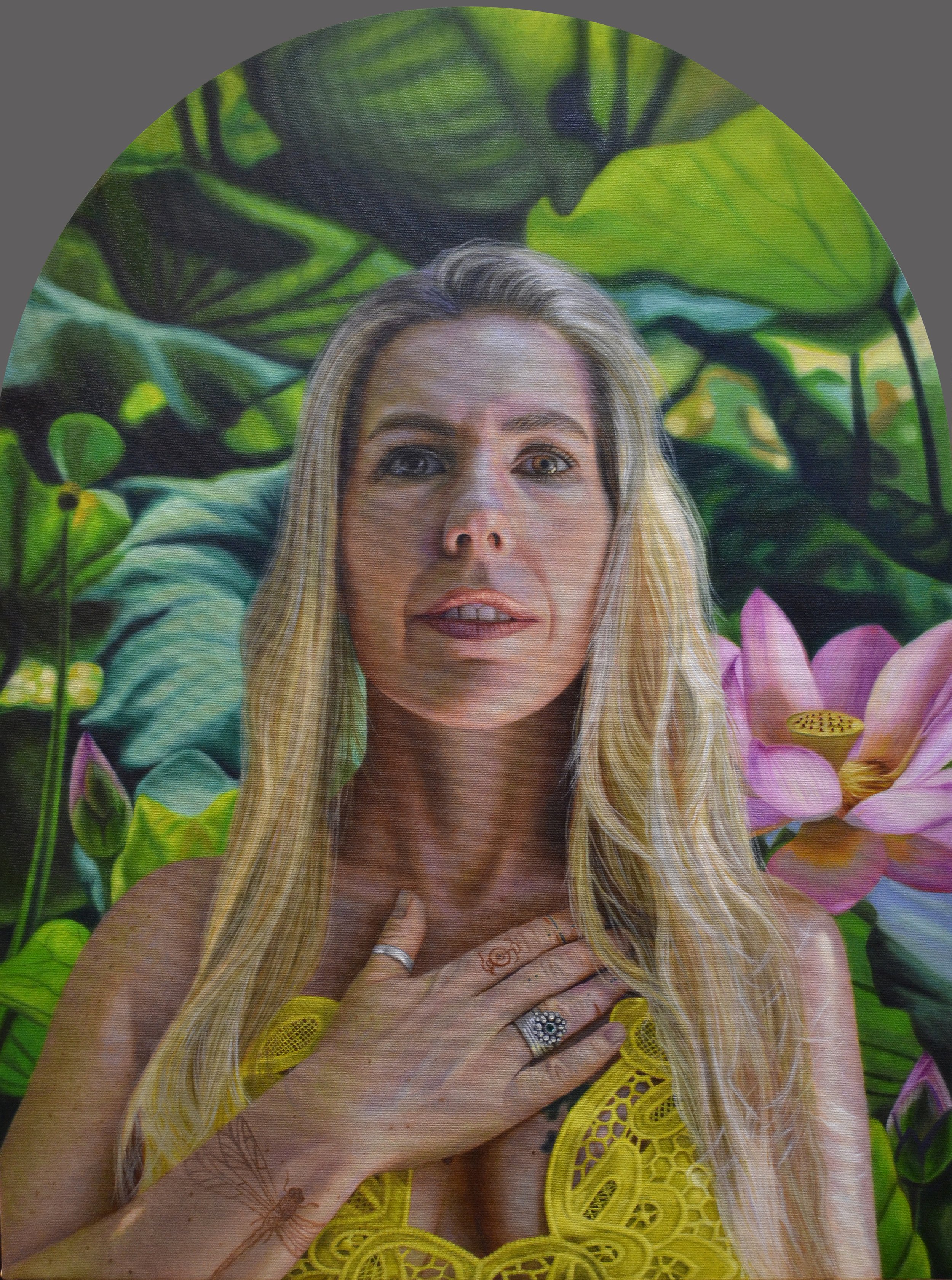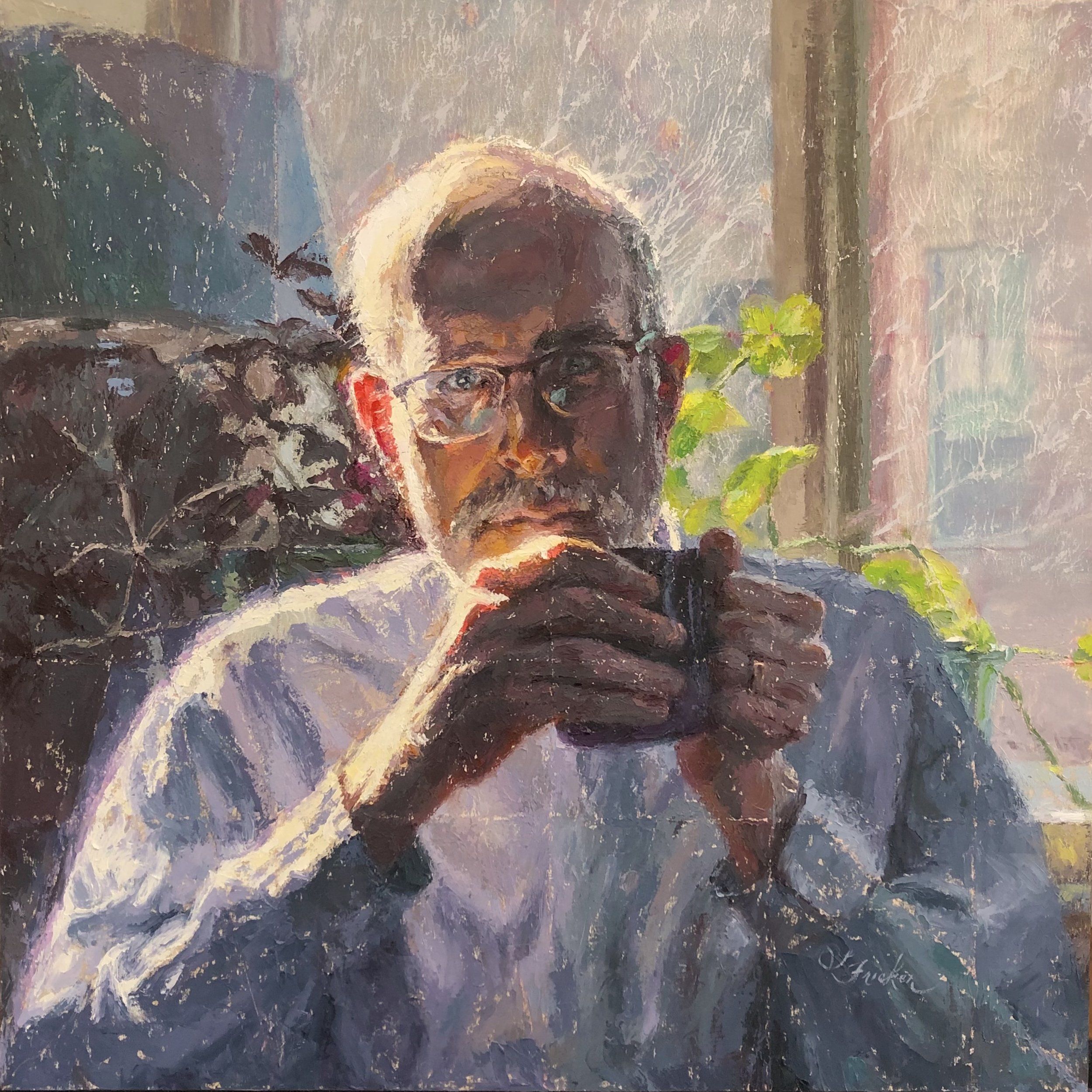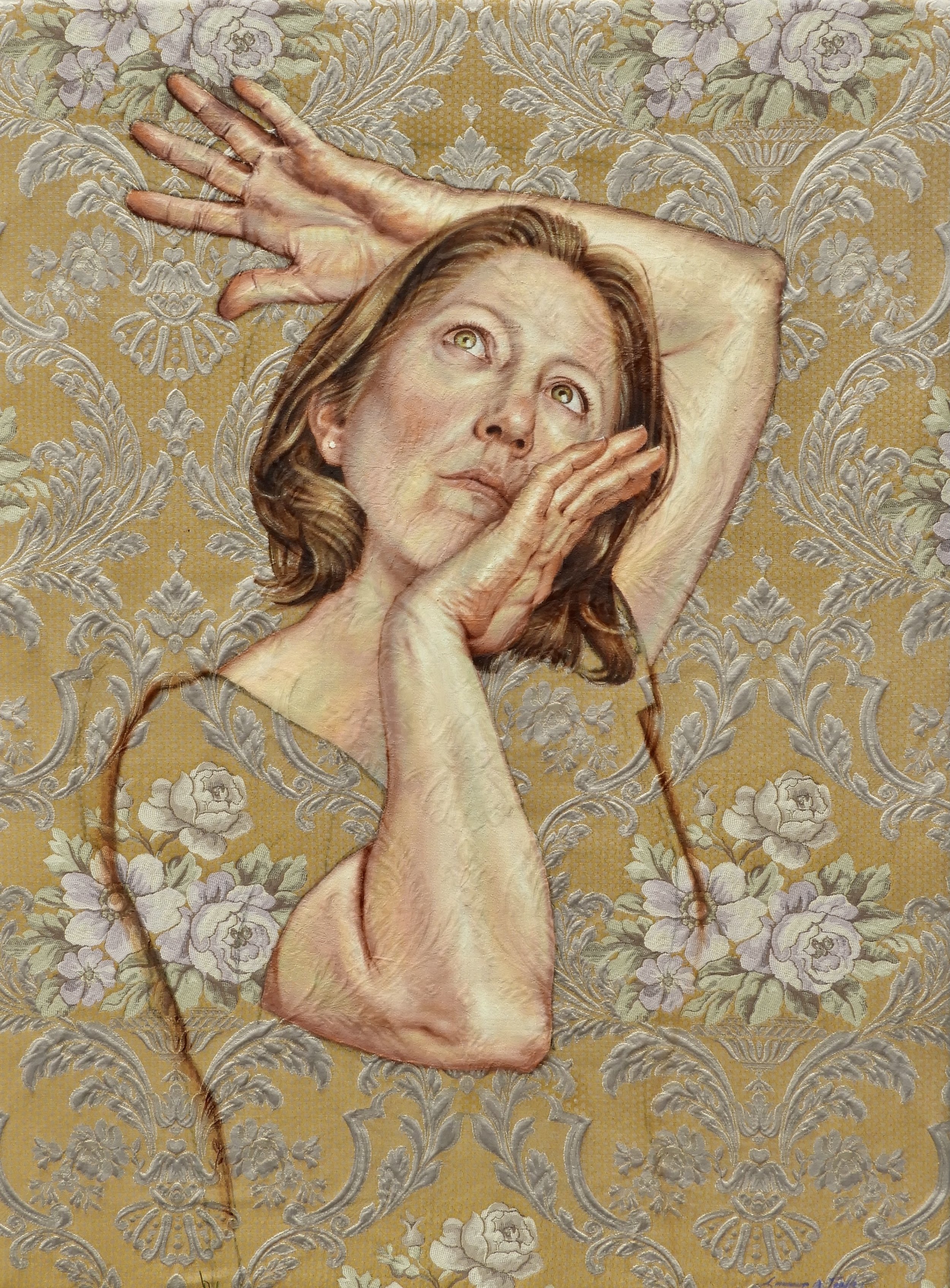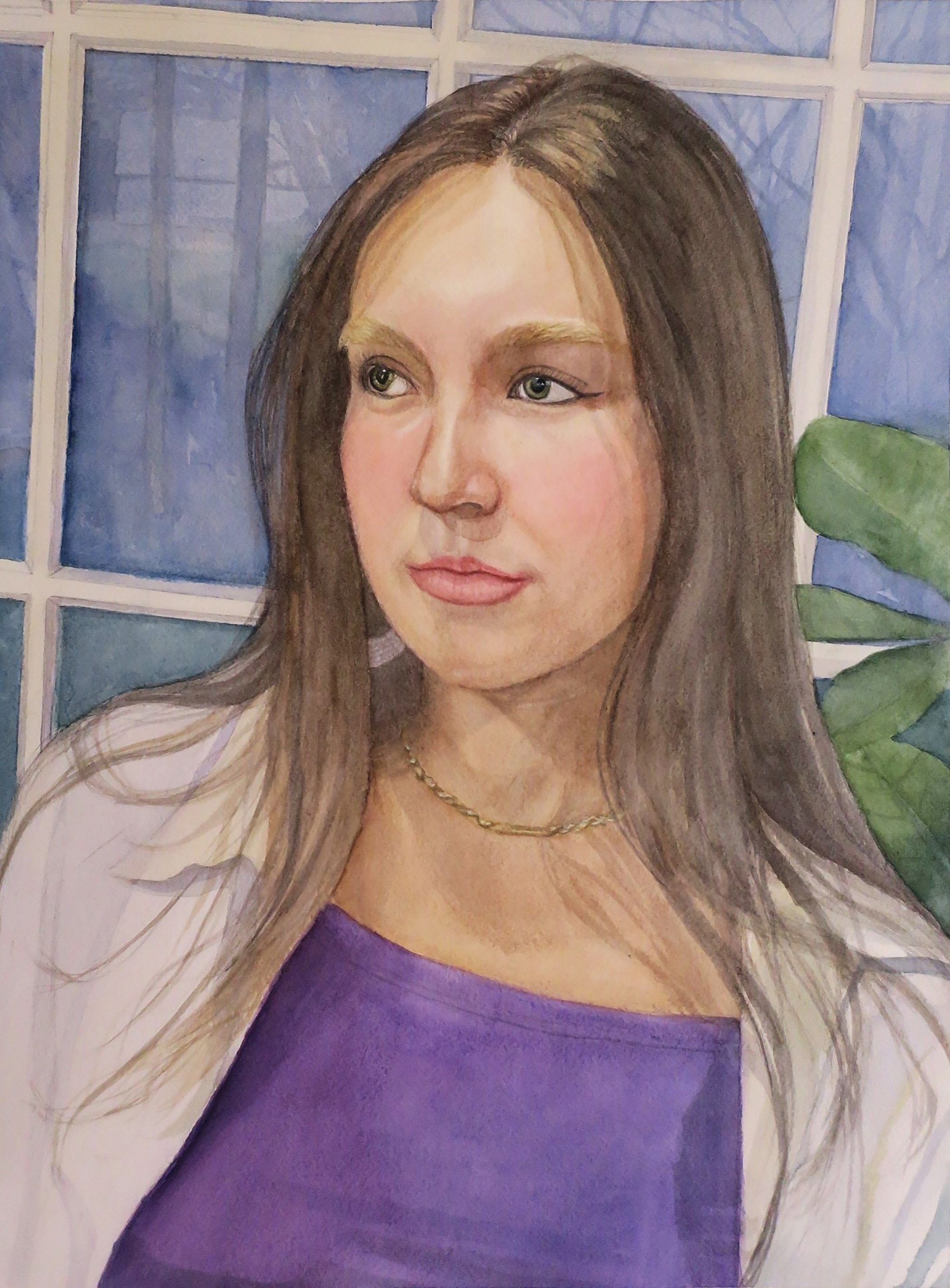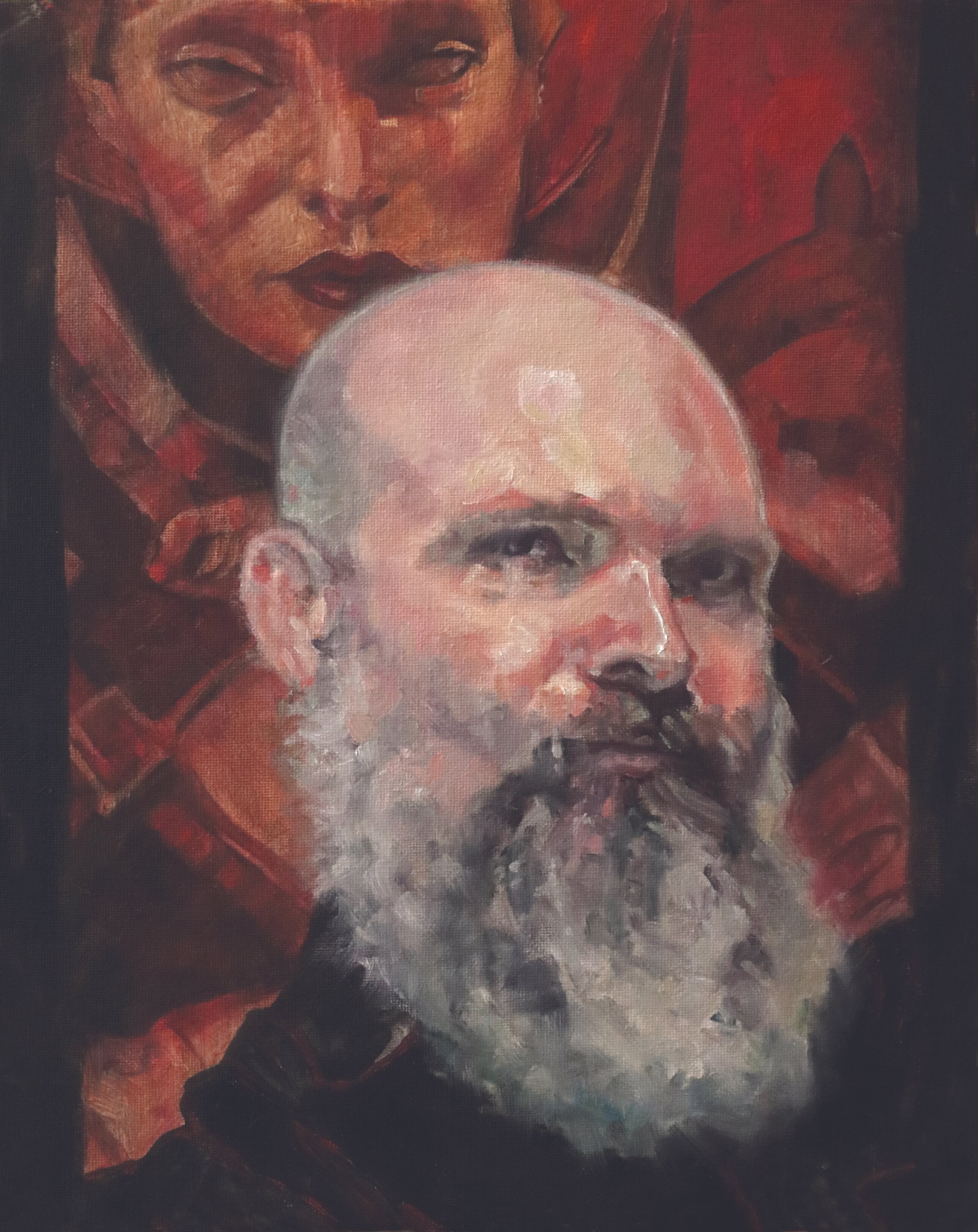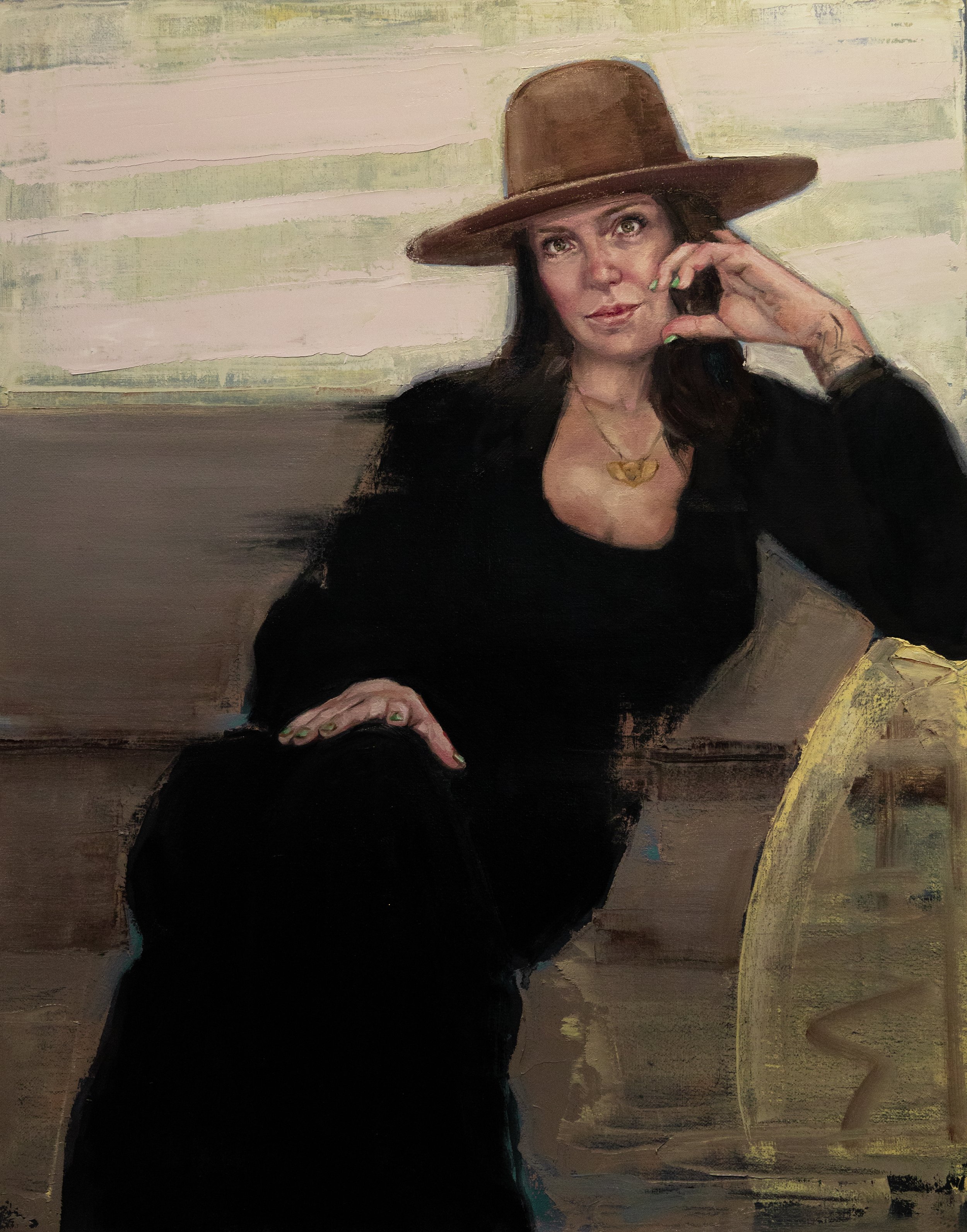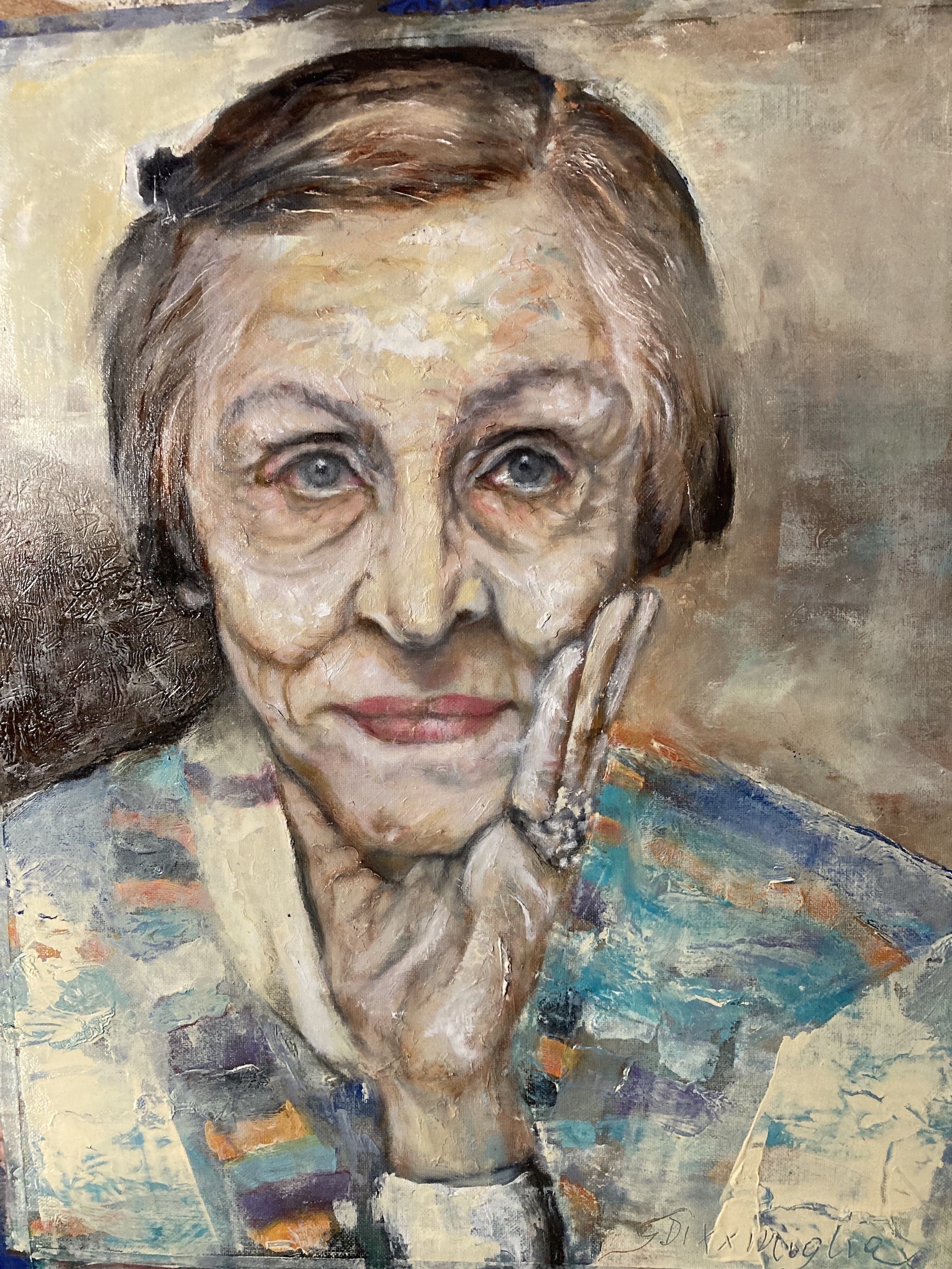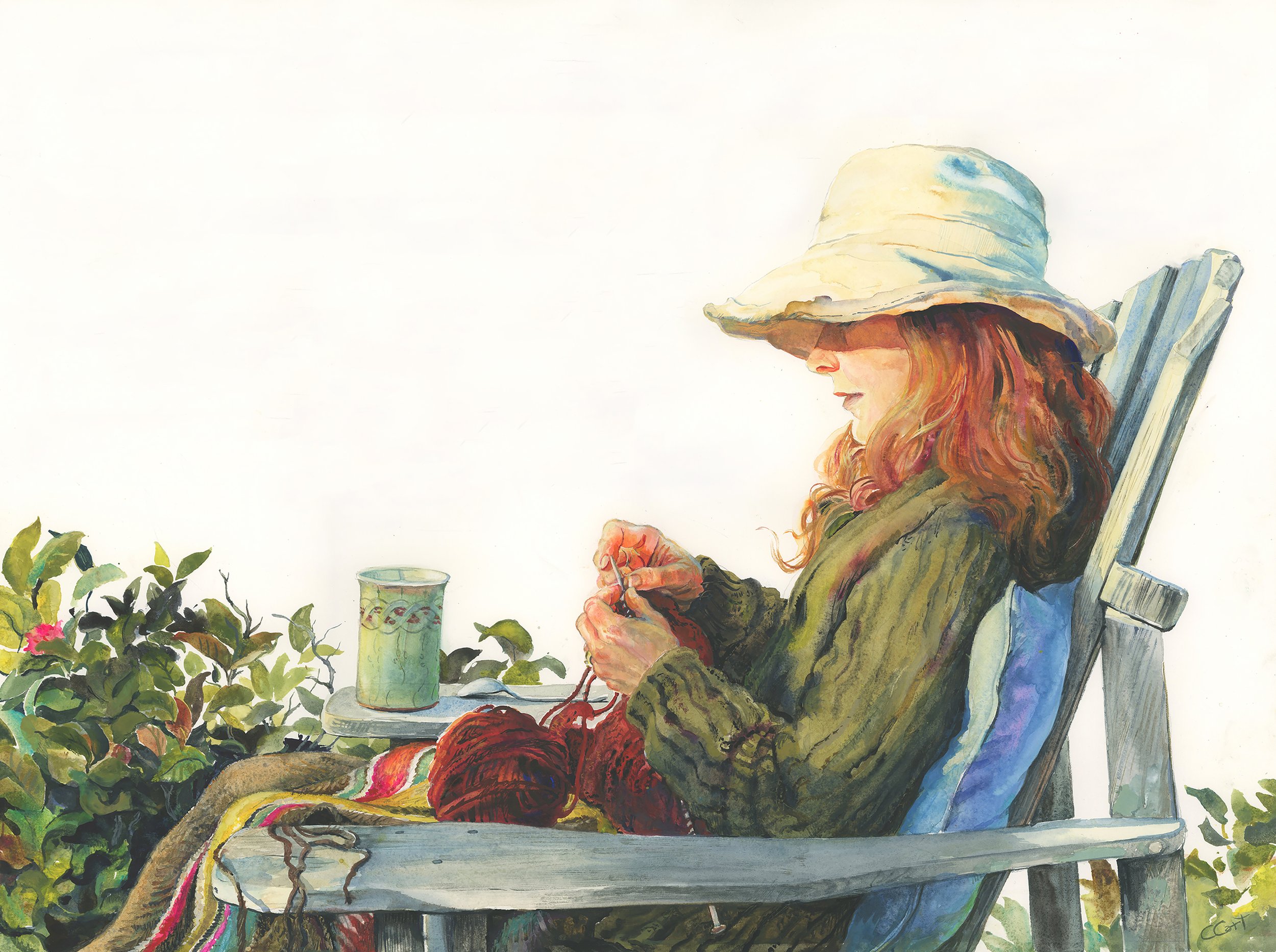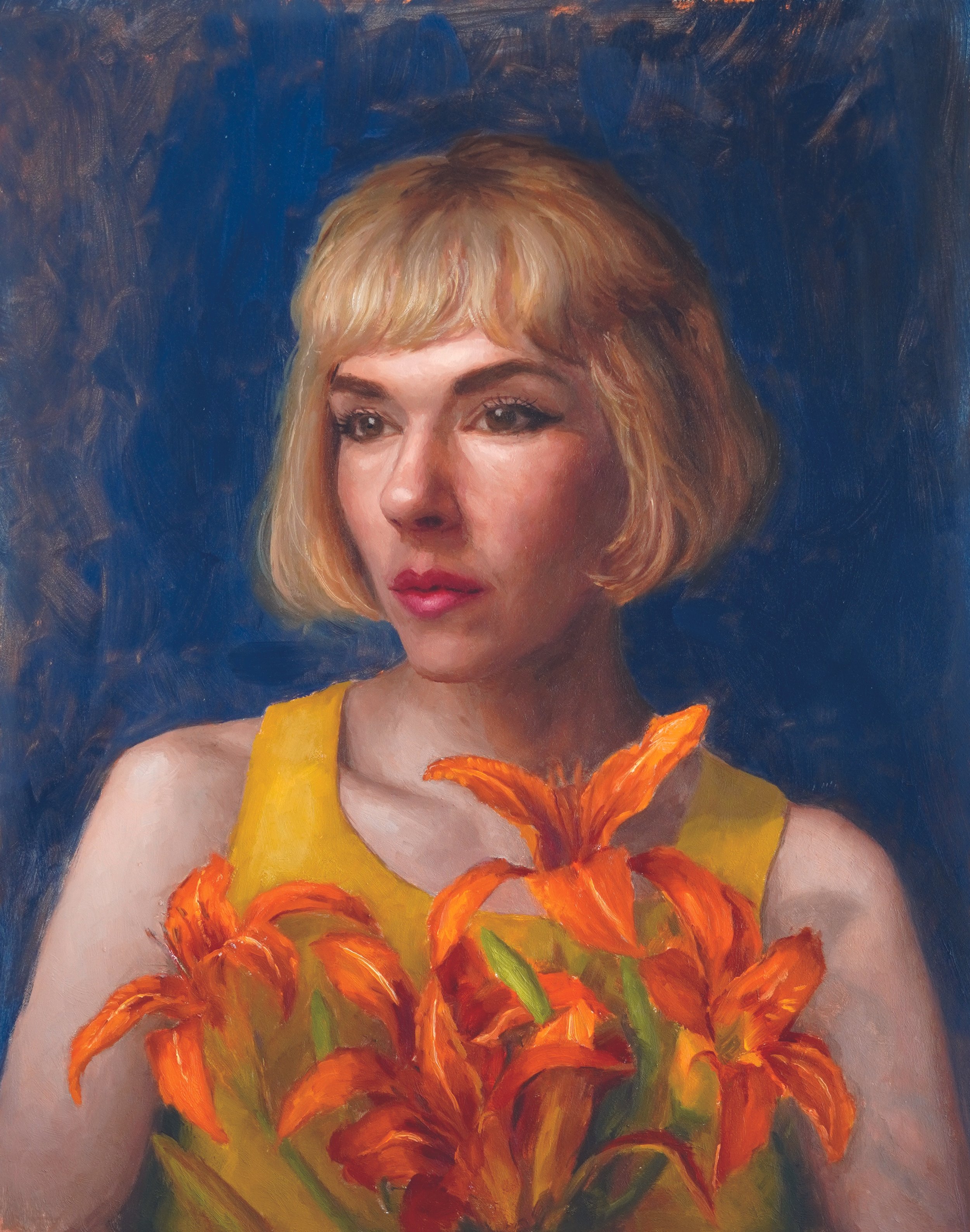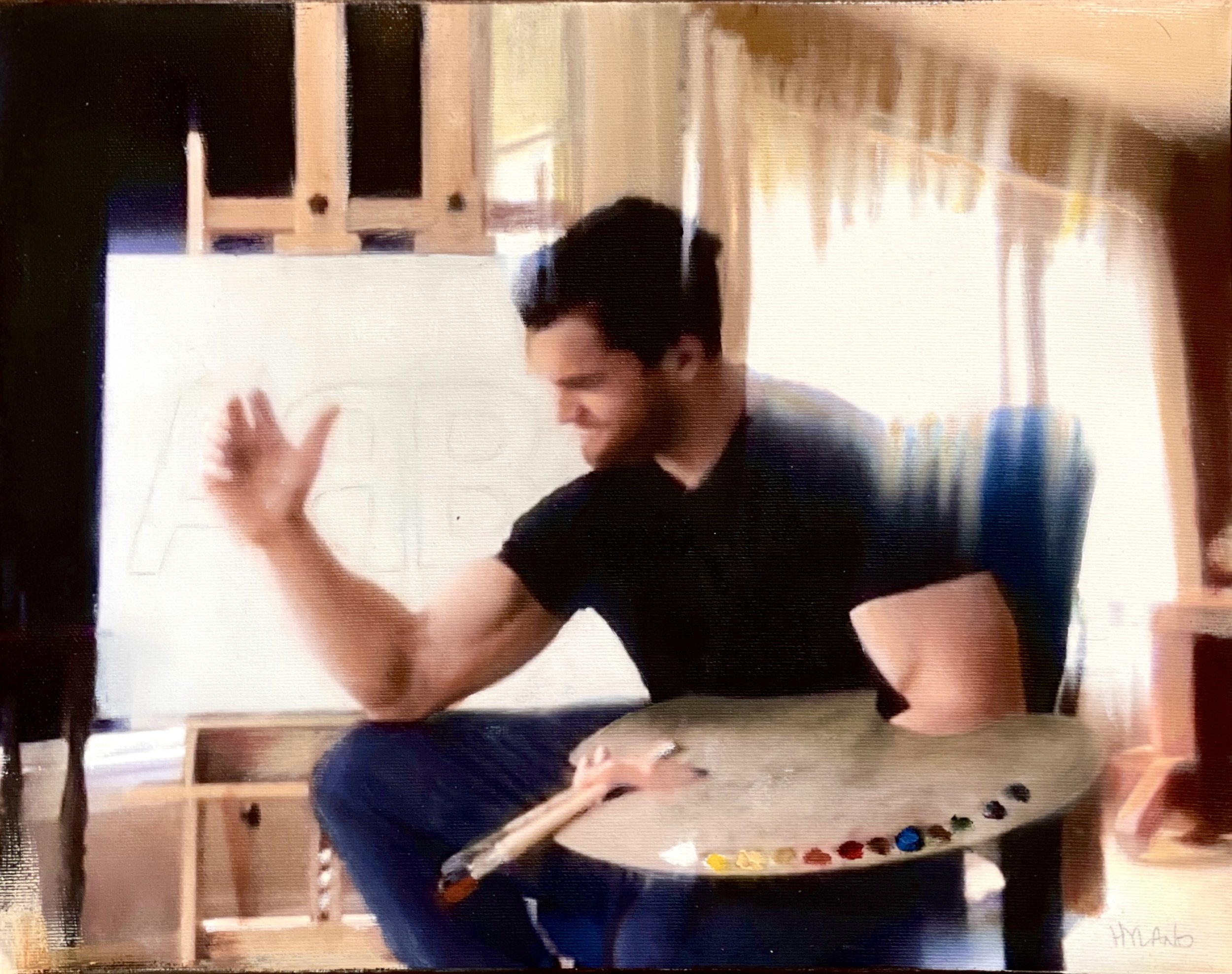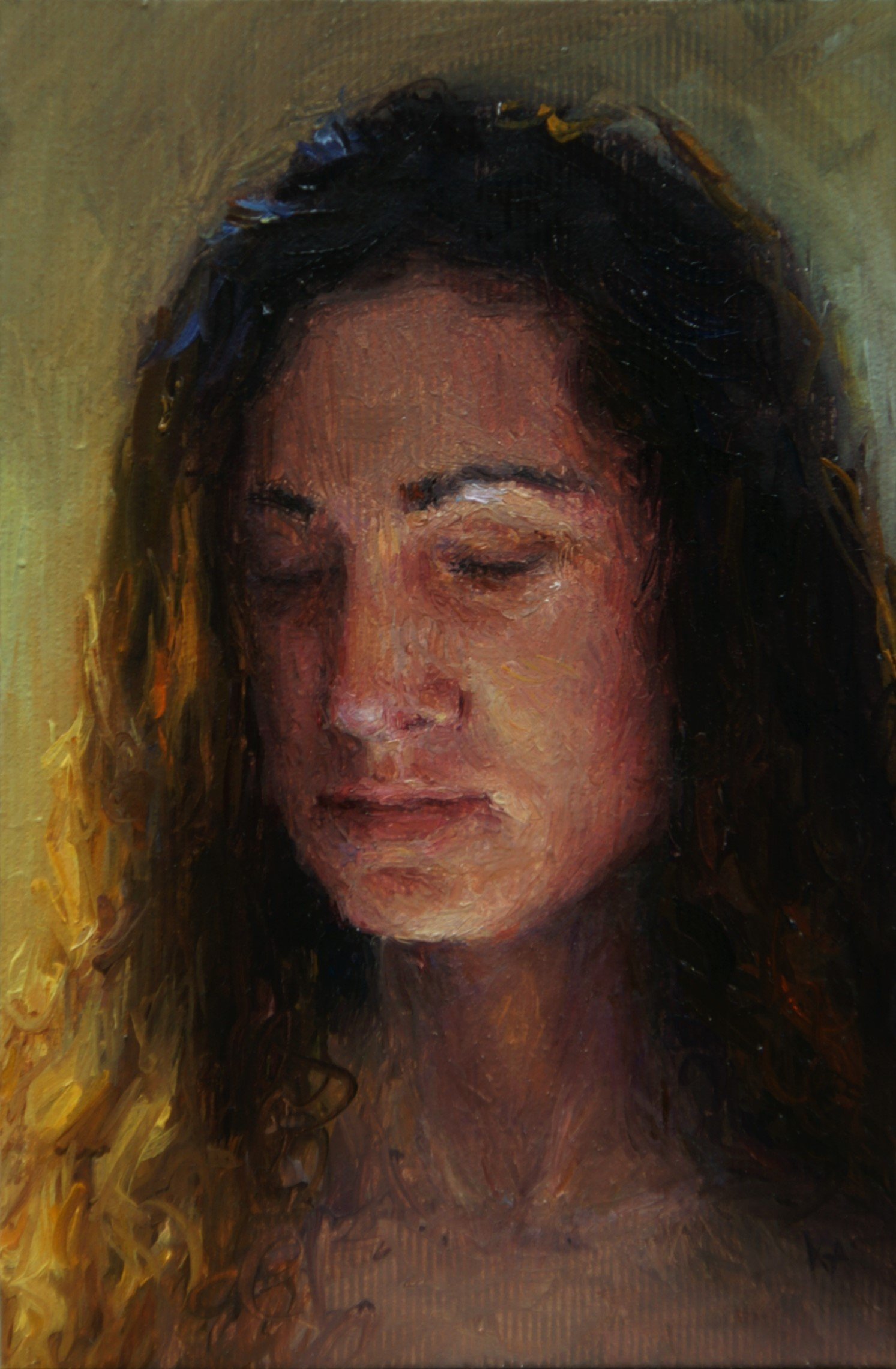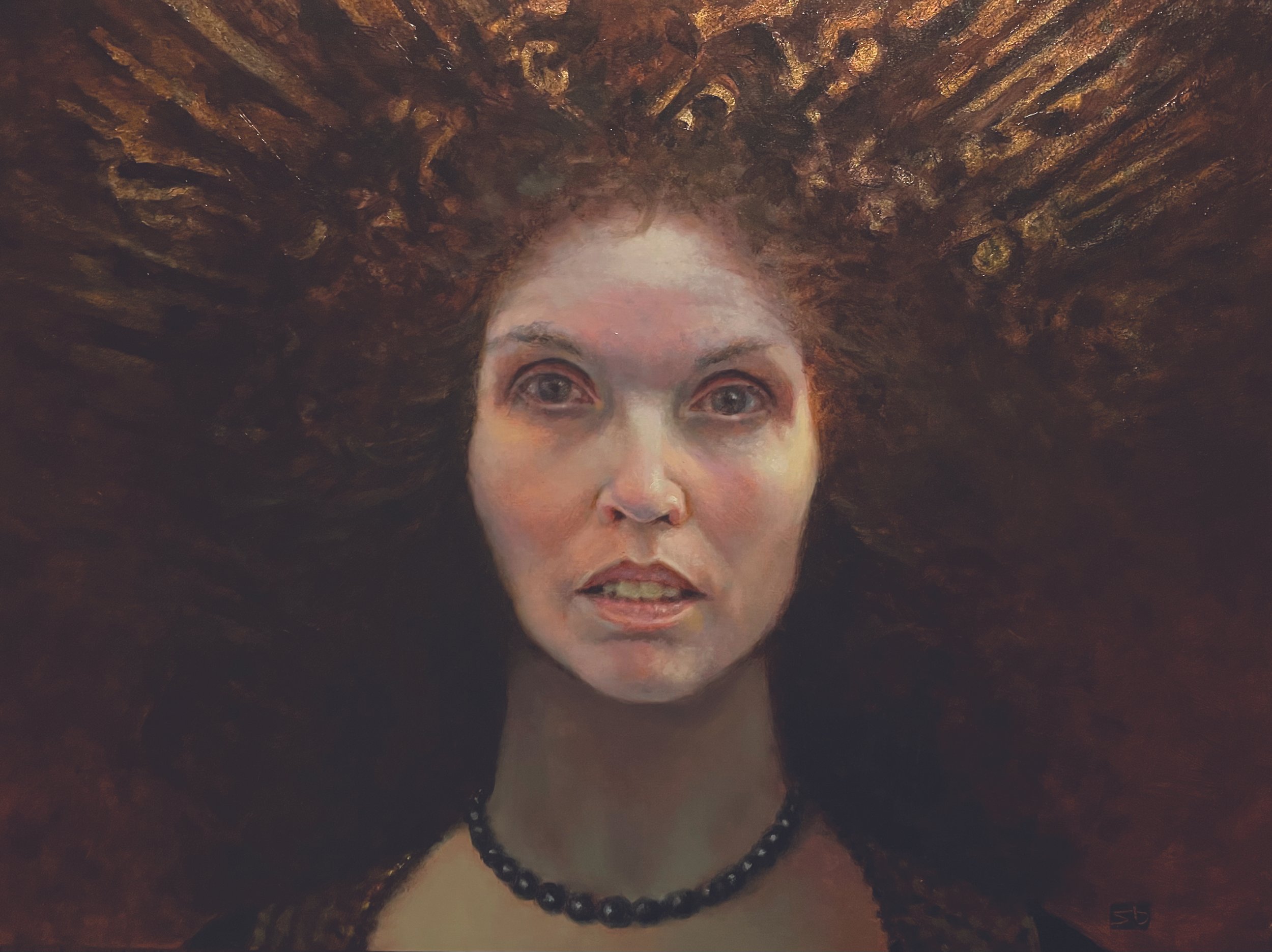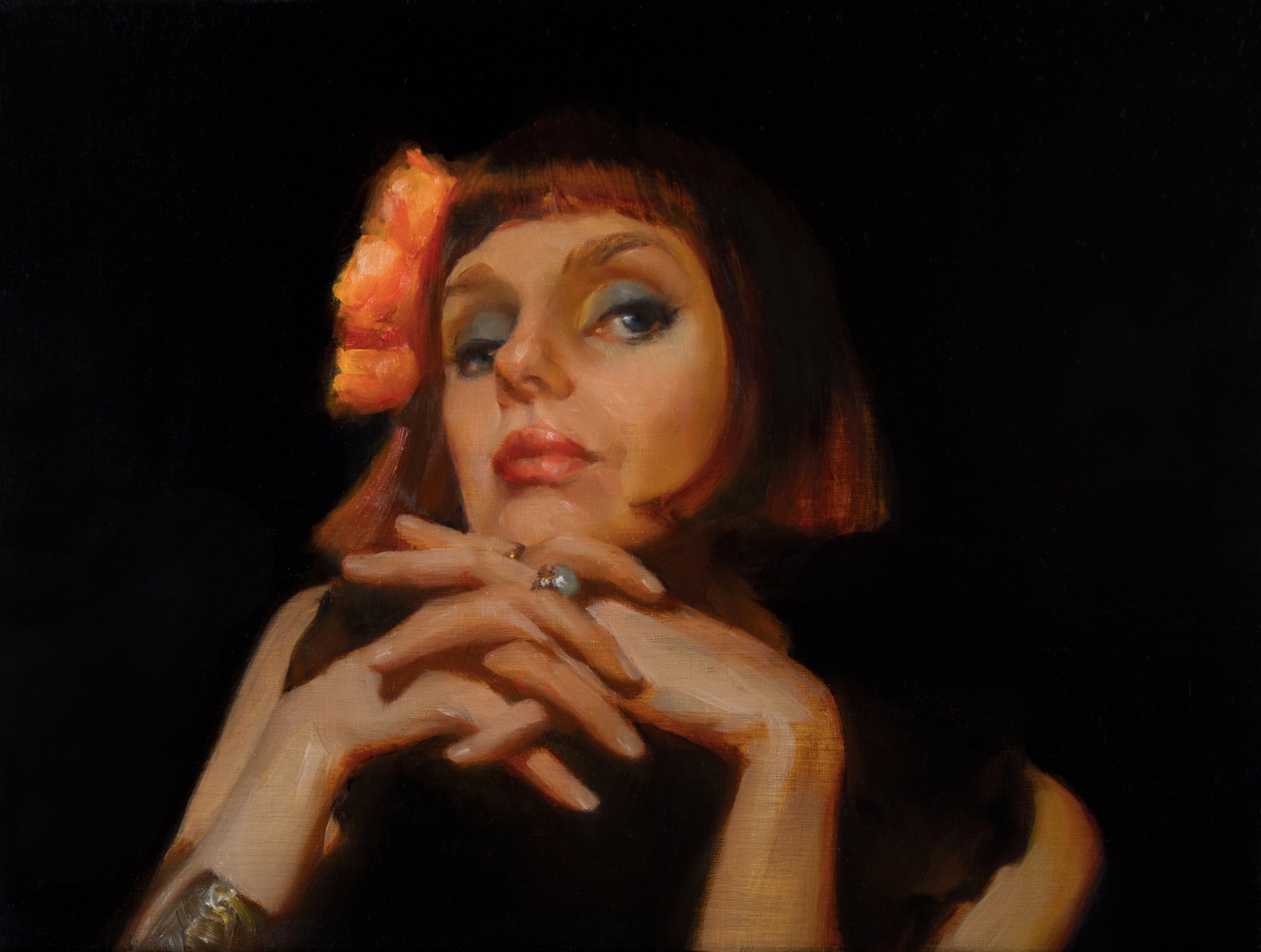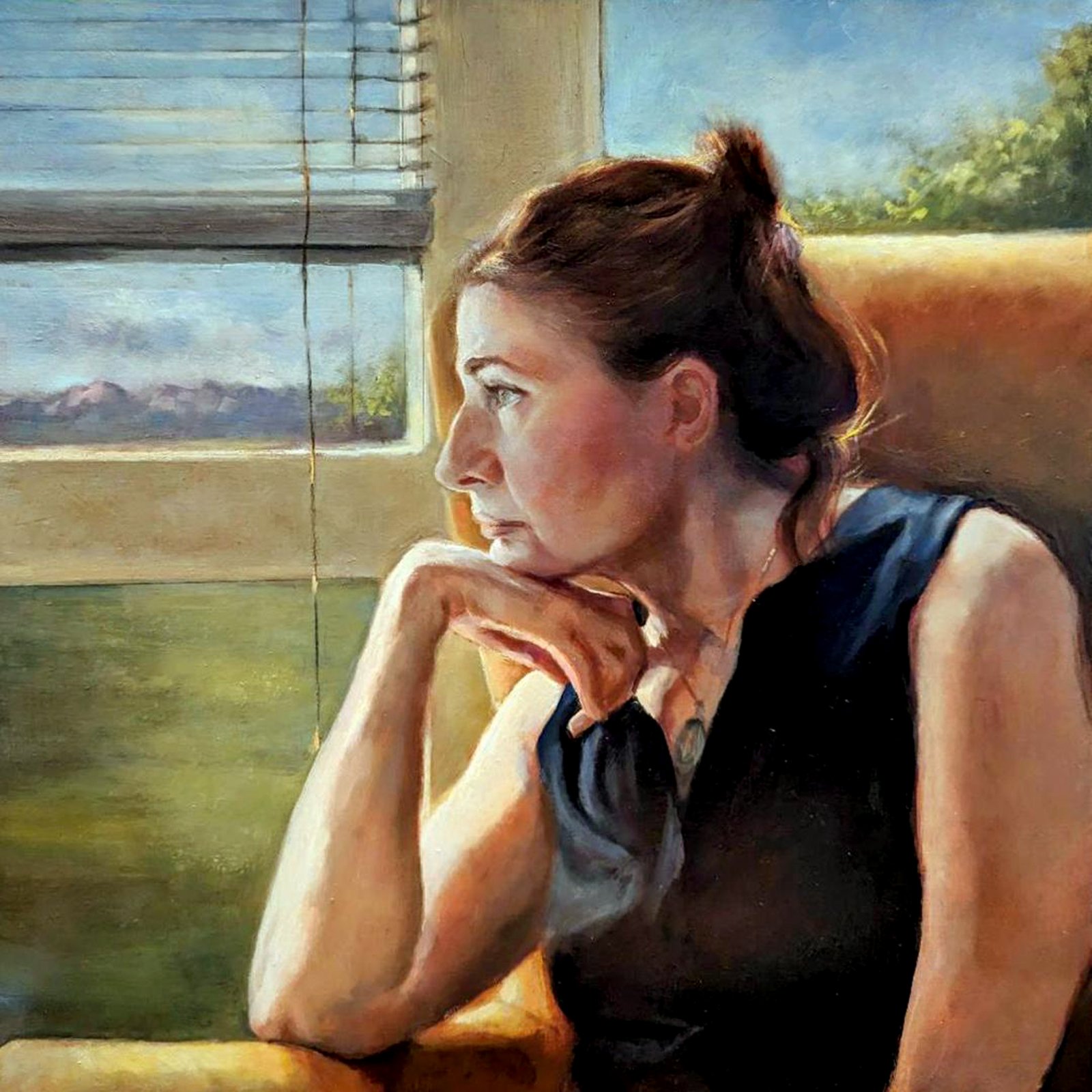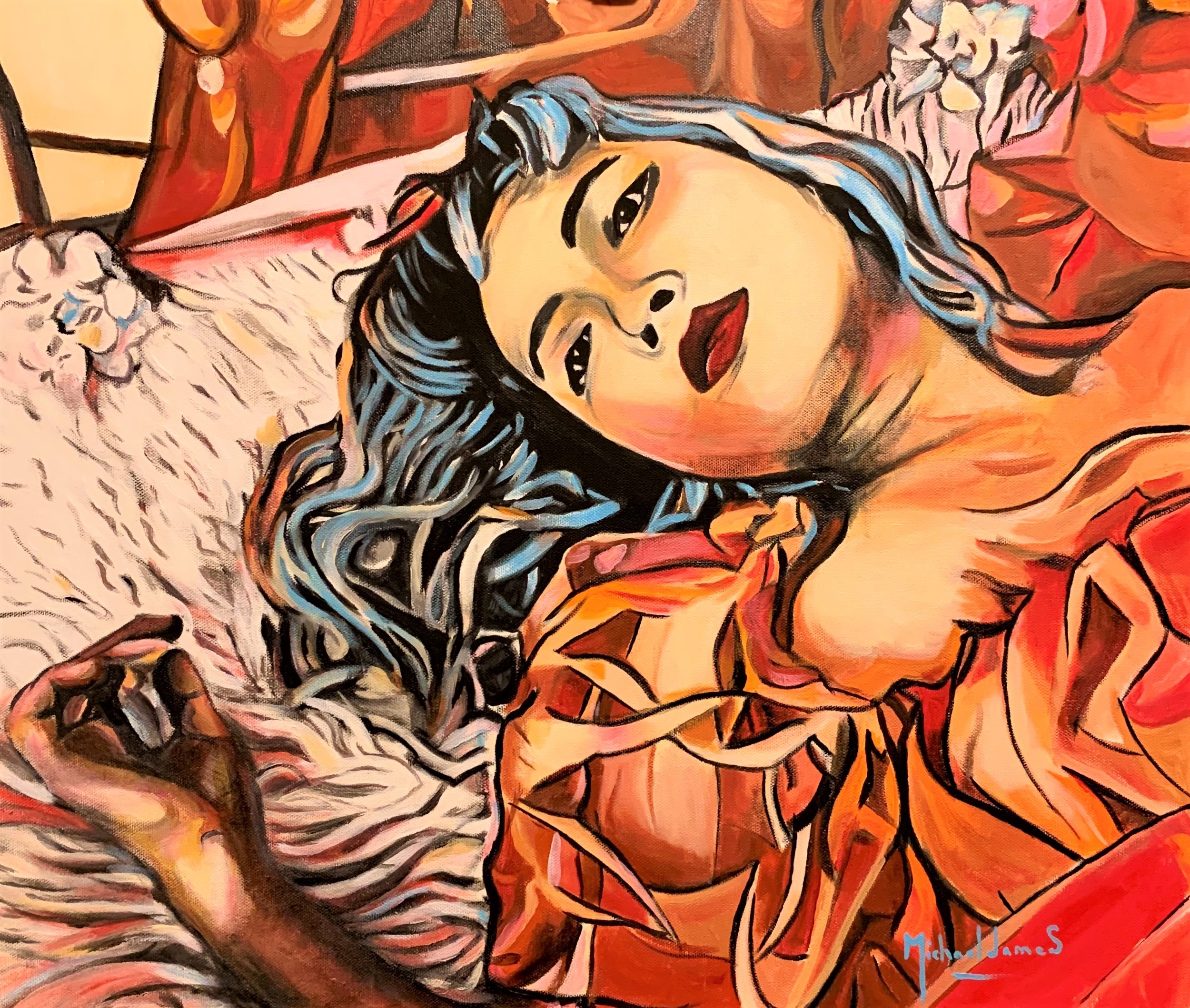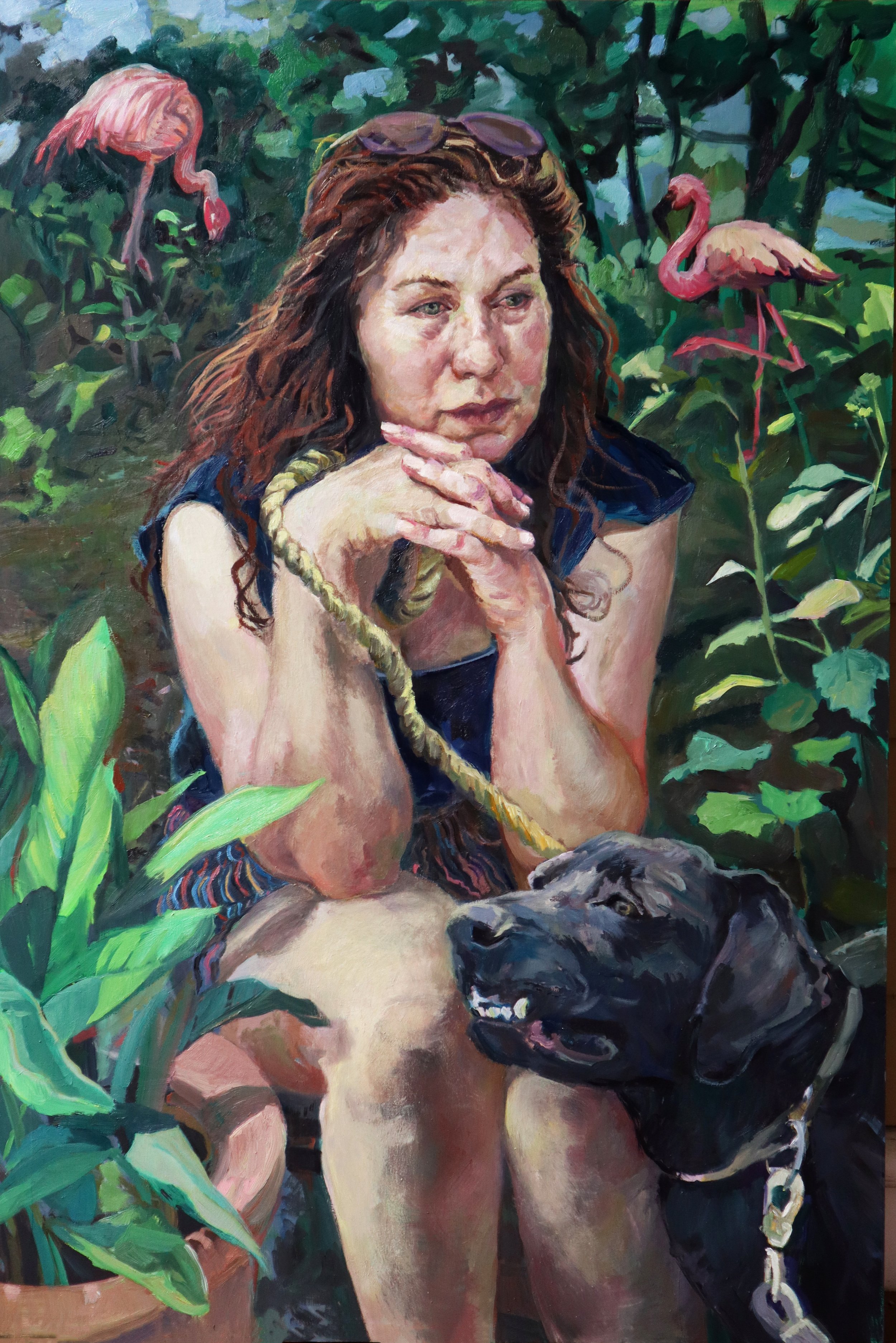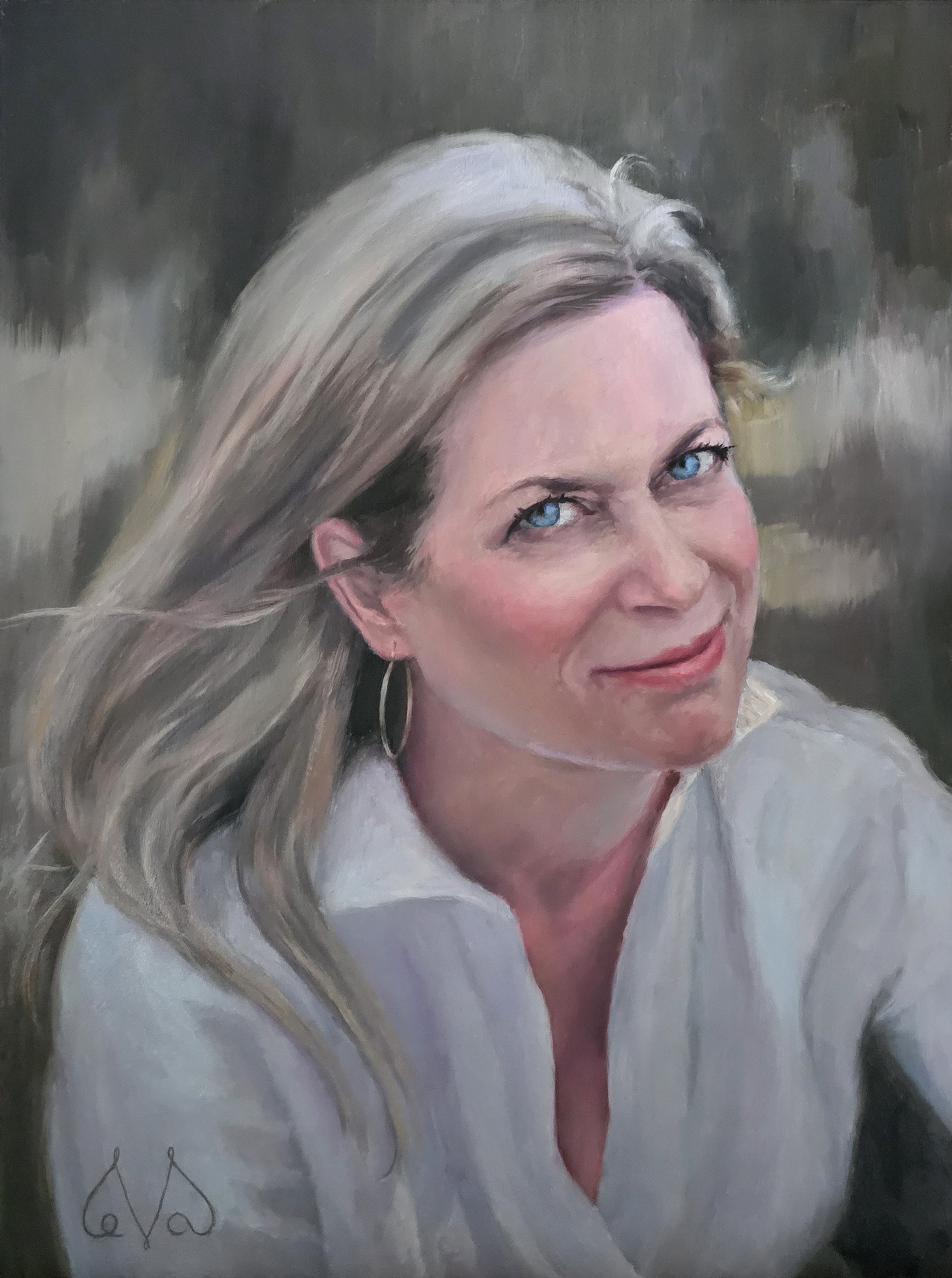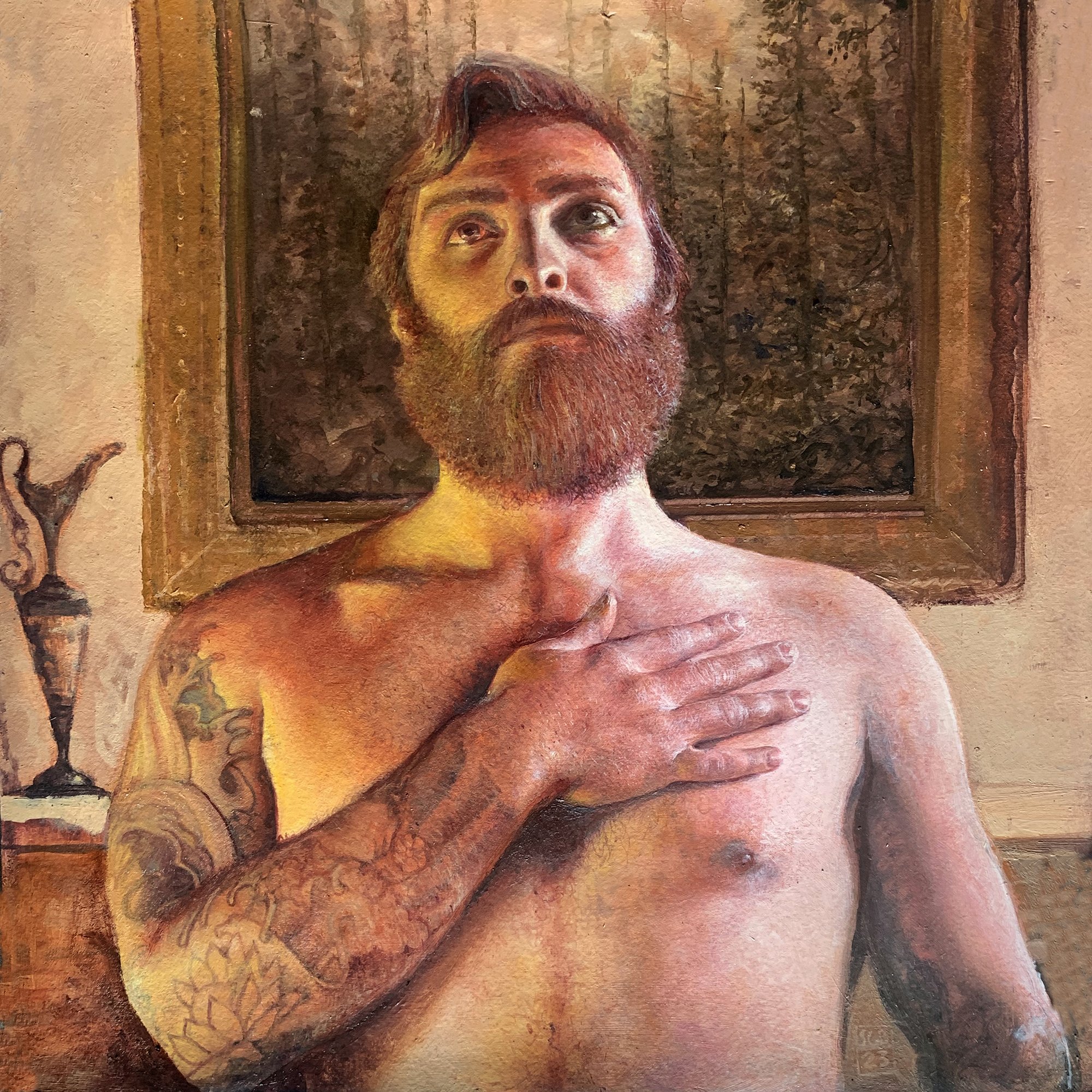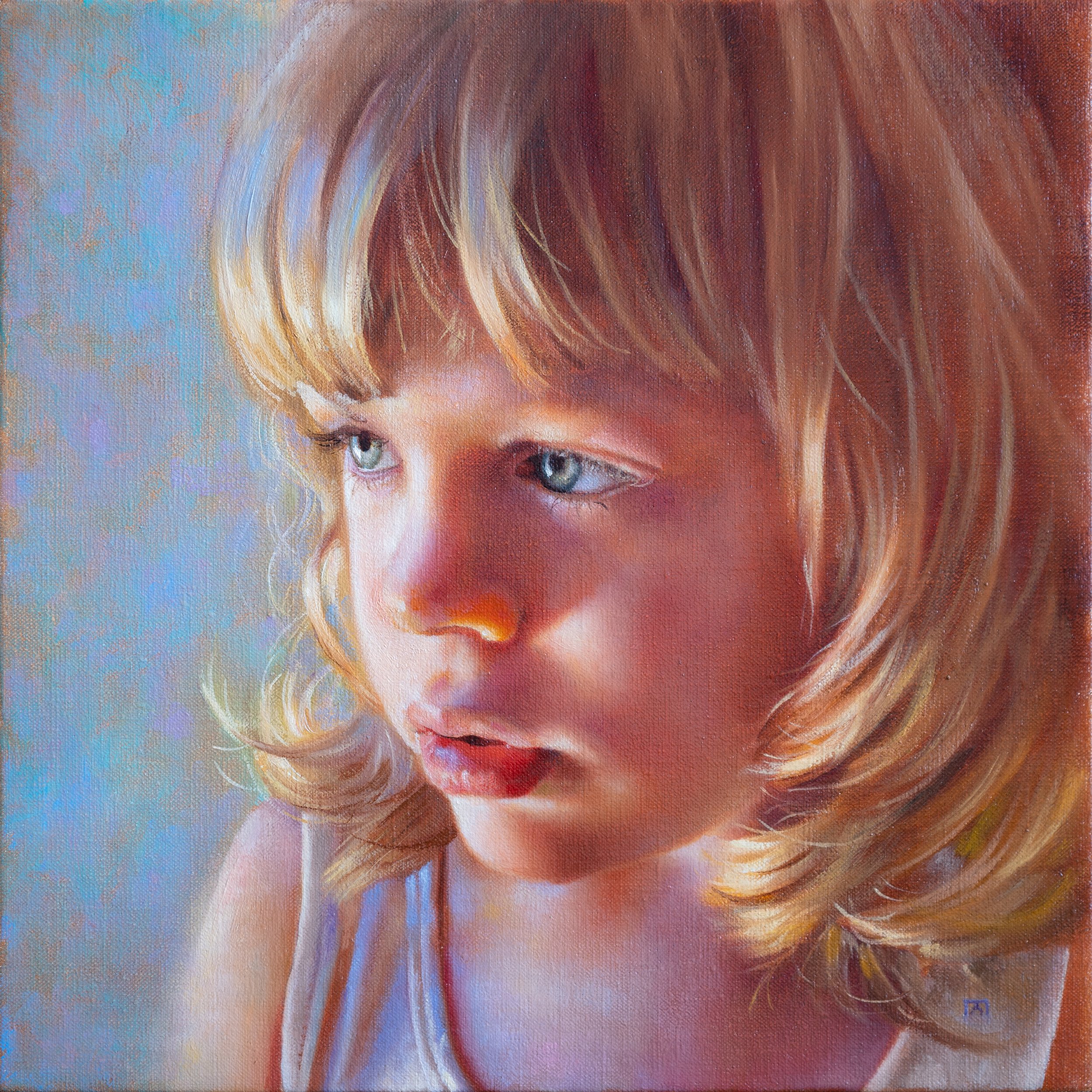Lukas Moll is a queer artist based in Cologne, Germany. His work is deeply rooted in the experiences and struggles of the LGBTQ+ community, aiming to bring visibility to themes like isolation, discrimination, and resilience. He also explores topics such as sexual violence and abuse, using art as a medium for healing and advocacy.
Read moreBIOPIC | Alexandra Manukyan →
Alexandra Manukyan is a talented artist known for her surreal and figurative oil paintings. Her work often explores themes of human connection, strength, and the impact of individuals on their surroundings. She portrays strong, almost god-like women in her art, blending imagination with reality to create evocative narratives.
Manukyan employs a blend of classical and contemporary techniques in her paintings. She primarily works with oil paints, which she appreciates for their rich texture and slow drying time, allowing her to create intricate details and subtle transitions. Her process often involves glazing and scumbling, techniques that add depth and luminosity to her work.
Her style is rooted in figurative art, showcasing her deep understanding of human anatomy and proportion. She draws inspiration from classical portraiture, reimagining it through a modern lens to create vivid, ethereal compositions. Her background in fashion design also influences her attention to fabrics, textures, and composition.
Alexandra Manukyan's artwork delves deeply into themes of resilience, human struggle, and the coexistence of strength and vulnerability. She often portrays figures--especially women--as powerful yet tender, wrapped in elaborate, symbolic costumes or surrounded by surreal elements. These motifs create a narrative about the complexities of life and the balance between inner strength and external challenges.
Her paintings frequently explore environmental and societal issues, such as the human impact on nature or the psychological toll of modern life. Through her striking visuals, she invites viewers to reflect on themes of identity, connection, and transformation.
BIOPIC | Viktoria Savenkova →
ADD TO YOUR ART COLLECTION @ARTSY
Viktoria Savenkova is a talented artist known for her evocative and psychological portraits. Her work often explores themes of inner turmoil, human emotions, and societal expectations. She uses her art to delve into the complexities of the human experience, creating pieces that invite deep reflection and conversation.
Savenkova portrays the tension between an individual's inner thoughts and outward expressions. Her paintings often reflect the struggle between personal desires and societal expectations.
Many of her works highlight the fragility of human emotions. She captures raw, unfiltered moments of vulnerability, allowing viewers to connect on a deeply emotional level.
A recurring motif in her art is the metaphorical "mask" that people wear to conform or protect themselves. This idea symbolizes the dissonance between one's true self and the personas they project to the world.
Her work explores feelings of solitude and the longing for genuine human connection. Through her evocative use of colors and composition, she conveys both the pain of isolation and the hope for understanding.
Some of her artworks critique social behavior and collective norms, inviting reflection on how societal pressures shape individual lives.
Savenkova's art often uses contrasting elements--such as light and shadow or sharp and soft textures--to symbolize the complexity of these themes. Her ability to convey profound meaning through visual storytelling makes her work resonate deeply with viewers.
Like Savenkova, many contemporary artists explore themes of personal and collective identity, including race, gender, and cultural heritage. However, Savenkova's focus on the psychological depth of individual emotions sets her apart from artists who emphasize broader social narratives.
Savenkova's art resonates with universal themes but stands out for its deeply personal and emotional perspective.
33PA Showroom | Tim Okamura →
Tim Okamura investigates identity, the urban environment, metaphor, and cultural iconography through a unique method of painting. Urban life and hip-hop has greatly influenced Okamura's subject matter in his paintings - he often blends classical techniques of oil painting with the spontaneity of spray painted graffiti, combining the academic "realism" of his portrait and figure painting with modern graphics set in contemporary urban environments. The juxtaposition of the rawness and urgency of street art and academic ideals has created a visual language that acknowledges a traditional form of story-telling through portraiture, while infusing the work with resonant contemporary motifs.
Okamura has had several solo exhibitions in New York and Canada. His work has been shown in several prominent group exhibitions, including After Matisse/Picasso at the MOMA PS.1 in Queens, New York, as well as the BP Portrait Awards Exhibition at London's National Portrait Gallery. Okamura was invited to The White House in 2015 to honor artists whose work addresses issues of social justice, and received a letter of commendation from President Joe Biden. His 2020 portrait of Toni Morrison was chosen for the cover of Time Magazine and his portrait of Dr. Anthony Fauci was acquired by the National Portrait Gallery in Washington, DC. In 2021, the New York Historical Society acquired his 2021 painting Nurse Tracey, which was featured in the exhibition Dreaming Together.
Okamura - a recipient of the 2004 Fellowship in Painting from the New York Foundation for the Arts – has also had his paintings featured in several films including Pieces of April (InDiGent), School of Rock (Paramount), Jersey Girl (Miramax), and most prominently in Prime (Universal), a romantic comedy about a young New York painter starring Uma Thurman and Meryl Streep. Okamura's work is also notable in Ethan Hawke’s The Hottest State.
New Arrival | Yunior Hurtado Torres →
New Arrival | Angelika Weinekötter →
"Listening to the Universe" opens a space for the search for the transcendent. The seashell, a symbol of cosmic resonance, becomes a bridge between the inner self and the infinite. The gentle composition and the intimate gesture of the figure capture the moment when the inaudible becomes palpable—a silent dialogue with the metaphysical order of being. In a world of constant noise, the work advocates for a return to the essential, subtle sounds of life and seeks to inspire a dialogue between humanity and the infinite.
Read morePatricia Schappler | Evocative Paintings →
American artist Patricia Schappler is best known for her evocative figurative drawings and paintings. She combines realist and expressive traditions of observation, memory, and imagination, creating sprawling narratives of family life. Her work is characterized by strong lighting and expressive surface. Rooted in home; themes of birth, childhood, motherhood, aging, and partnering, recur. She is inspired by the complexity of human relationships and the bonds that hold them. Schappler is a native of New Hampshire with her BFA in Drawing from the University of New Hampshire, and her MFA in Drawing and Painting from Brooklyn College. You may see her work published in magazines which include American Art Collector, Pastel Journal, American Artist, Strokes of Genius, Manifest INPA and INDA, PoetsArtists, and Studio Visit. Schappler has exhibited nationally and in Ireland, and her awarded works may be found in both public and private collections throughout the States, India and China.
What's the purpose or goal of your work?
Most of my work begins with the desire to share a meaningful image and in that sense, connect with the viewer. I want to create moments of recognition whether through a familiar gesture, a quality of light, or the passage of time which reaches the viewer in a way that remains, so we join within the space of the work as friends.
Which art trends inspire your current work?
I look at contemporary realism and work from centuries past equally, swayed by quality, mood, and conviction. I love pattern and look at textiles from around the world and have been thinking more about connecting the spaces I’m interested in: nature/our planet, animals and the figure.
How do you manage a work-life balance as an artist?
Sometimes managing a work life balance is messy. I teach drawing and painting, paint out of a home studio, have four adult children just beginning families, and an extended family with both spectrums of newly born and far into the aging process. I exhibit as regularly as possible and don’t when I can’t. At the moment, I have work at WMOCA, and at the Dunfey exhibit, as well as online with 33 Contemporary. Within the next month, I’ll be exhibiting with Great Bay Community College, New Hampton School, and St Anselms College. Work balances with family, tipping to and fro depending on human needs, but art is a way of living and never far from my thoughts and actions. I have a lot of good energy, prioritizing home and community and within that, finding many subjects and points of inspiration.
What are your favorite and least favorite parts of professional art?
I love the process of thinking and doing, creating something from ideas and observations, moving materials in my hand, watching work come to life through methods and processes until something that wasn’t much becomes something satisfying, engaging… shared. The same applies to seeing works and engaging with ideas, feeling enlightened through another persons’ choices. Demands of social media and marketing are time consuming activities and add to pressure over deadlines, time which I’d prefer to spend in the studio.
What are your most valued skills as an artist?
I see with empathy.
Do you have a network of other artists, and how do they support you?
I have a small local group of artist friends…we comment on imagery, let each other know when competitions are coming up, try to attend exhibits where we have work from the group, hurrah each others’ wins, and in general help each other to feel a part of something a bit bigger than ourselves. I am also part of several artist associations and groups like PoetsArtists where even if I’ve never met the members, we feel like we know each other from our posts, our art work, our general enthusiasm for each other.
How can your work affect societal issues?
I’m not making work that directly affects societal issues and yet I cannot make work that isn’t about society, how I am feeling within it, where my concerns lay. I’m a woman, a mother, daughter, wife, instructor, artist, so many labels, but it comes down to creating images as a window into my life giving voice to experiences both of joy and sorrow, and, in the process, discovering domestic and heroic scenes are not dissimilar. I present figures through the lens of wonder and respect, the sharing of stories around themes of family, friendship, home … I believe when we recognize loved ones in others, we remember the best of what it is to be human, so perhaps I’m working on my own quiet revolution that celebrates humanity, resiliency and possibility.
O'Neil Scott | Captivating Portraiture
O’Neil Scott is a Pennsylvania based representational oil painter. Captivated by portraiture and its capacity to impart complexities that comprise the human condition his work is designed to give a voice to marginalized communities. His paintings convey contemporary subject matter and look to give the viewer a way to understand and relate across social boundaries. He had his third solo show in 2022 and has been in numerous publications including Fine Art Connoisseur Magazine, American Art Collector Magazine, and Artist Magazine. His work is in private collections across the United States and Internationally. He currently has a solo exhibition planed for Villanova University in 2022 and a Solo Museum Exhibition at the Zillman Art Museum in 2025.
Kim Leutwyler | Painting the LGBQT Community
Born in America, Sydney-based Kim Leutwyler migrated to Australia in 2012. She works in a variety of media including painting, installation, ceramics, print media and drawing. Leutwyler's current body of work features paintings exploring notions of beauty, gender and queer identity. She has come to focus on painting as a medium because of its primarily masculine history in the western art canon. Her artwork has been exhibited in multiple galleries and museums throughout Australia and the United States.
Rachel Linnemeier | Complex Figures
Rachel Linnemeier’s subject matter includes powerful women in situations that both evoke strong feelings of nostalgia and inspire narratives. The overarching theme of Rachel’s work includes tension between the idea of modern adulthood and residual childhood. Each piece is composed of bright and vivid colors creating a youthful feeling while simultaneously expressing maturity through the pose and expression of the figure. Recent works have begun to explore the addition of landscapes to create complexity in narrative.
Add to your art collection @Artsy
Ann Moeller Steverson | The Emotive Figure
Ann Moeller Steverson is an American artist known for her emotive and mood filled figurative works, primarily created with oil on copper. Her works are described as having a timeless quality which invites the viewer to create their own sensitive response and narrative through a compelling tension and sense of mystery. Through the quiet intensity of each piece she seeks to share her most authentic self, what she loves, and an invitation for connection. Born in Huntsville, Al, in 1980 she continues to reside there, working within a vibrant artist community. There she paints, teaches, and operates an atelier to promote the advancement of realism in modern painting.
Pauline Aubey | LEGO Art
Paulina Aubey uses lego bricks to create portraits who question our relationship to cultural icons through an interplay between abstraction and realism. Inspired by stained glass, she now adds some luminous effects to her artwork using a superimposition of matte and transparent bricks that she calls glazing. She mainly focuses on intimate close-up portraits that remain undecipherable despite close inspection. Her body of work is an attempt at alleviating the inherent tension between technology and mysticism. She is part of the Lunar Codex and a judge for Lego Masters France.
Chris Clark | Hair Culture
Chris Clark is a self-taught visual artist, illustrator, and muralist living and working in Jacksonville, Florida. Art, to him, is a form of journalism.
Using acrylic, oil, ink, and spray paint, he explores the rich culture and history of the Black community across the diaspora and the social issues affecting them today. For Clark, reflecting the human figure is very powerful, which is why he uses graphic-style portraiture and figurative works to depict Black life in America through his personal lens of a Black man. At the core of his work is the notion that representation matters. As the artist explains, “By telling my story, I want to help the viewer rediscover theirs.”
Clark’s artwork has been shown in exhibitions around the U.S. and abroad, including his recent solo exhibition “New Growth” at Kent Gallery FSCJ in Jacksonville and at the Nelson Mandela Metropolitan Art Museum in Port Elizabeth, South Africa. He has received multiple art awards and grants for his work. Clark was chosen to participate in the House of Sedulo Artist Residency in London, UK and the Chateau Orquevaux Artist Residency in Champagne-Ardenne, France in 2022-2023. Most recently he completed his first artist fellowship the DEAR (Digital Evolution Artist Retention) fellowship through the Caribbean Cultural Center African Diaspora Institute in New York.
Amy Ordoveza
Amy Ordoveza is a contemporary realist artist who creates detailed, imaginative still-life paintings. She carefully crafts and arranges the delicate cut-paper plants, animals, and architectural elements that she depicts in her oil paintings. The fragility of the paper objects suggests impermanence while Ordoveza’s close observation and meticulous handling of paint hint at their significance. Her compositions evoke a sense of beauty and mystery in ordinary surroundings.
Ordoveza received her MFA from the New York Academy of Art and her BFA from the Maryland Institute College of Art. Her historical influences include 17th century Dutch still life painters including Rachel Ruysch and Jan Davidsz de Heem as well as surrealists such as Kay Sage and René Magritte. Ordoveza’s work is included in the Lunar Codex and the Nova Scotia Art Bank and has been featured in publications and websites including American Art Collector, PoetsArtists, and Booooooom!
Artists Painting Artists | A Window into Creative Souls →
Diana Carolina Lopez | Kate’s Resilience, 2023 | Oil on canvas | 31 9/10 × 23 9/10 in | 81 × 60.8 cm
In the realm of painting, there's a profound beauty in artists painting their peers. This practice is more than just a mere portrayal; it's a tribute, an intimate dialogue between creatives who share a relentless impulse to express. The online exhibition "Artists Painting Artists" magnificently en- capsulates this concept, offering viewers a chance to witness one artist's perspective of another's essence.
Imagine a world where each brushstroke is an ode, where every color and line is a symbol of respect for a fellow artist's journey. In this unique form of portraiture, the artist is both a narrator and a participant, engaging in an unspoken conversation with their subject. It's akin to self-portraiture, yet here, the artist sees themselves through the eyes of another, providing an external viewpoint that is often enlightening.
The exhibition leads us through various narratives, each portrait unfolding a story that beckons us to explore deeper. There's a certain magic in the gaze captured by these artists. It invites us to ponder, to lose ourselves
in the depths of the subject's character. What lies behind those eyes? What stories do they tell? These are questions that resonate throughout the gallery.
Historically, the art world is rich with examples of artists painting their contemporaries. These portraits are not just mere records; they are tes- taments, eternalizing the honor and reverence of being the subject of a fellow artist's canvas. They forge a bond across time, connecting the past, present, and future in a continuous thread of artistic admiration.
As you delve into this exhibition, let each portrait intrigue you, drawing you into the narratives they weave. Each piece is a journey into the heart of creativity, a celebration of the artistic spirit that connects us all. This is not just an exhibition; it's a homage to the enduring bond between artists, a tribute to the shared passion that fuels their creative souls.
- Sergio Gomez, MFA
Erica Calardo
Erica Calardo is a figurative painter living and working in Italy. Her works in oils, watercolors, and pencils are windows on the solitude of lost souls. She explores the realm of Beauty, Grotesque, and Magic, by creating eery oneiric feminine figures who tell tales of long forgotten dreams, of an imaginary timeless past.
Deeply rooted in the Italian Tradition, her technique is inspired by the Renaissance and Mannerism old masters (Leonardo, Bronzino, and Lavinia Fontana above all). She is mostly self-taught and has learned her skills from old dusty books. She has recently studied academic painting with Italian master Roberto Ferri.
Since 2010, she has showcased her work in galleries in Italy (Mondo Bizzarro, Studio21), and abroad (La Luz de Jesus - LA, Auguste Clown - Australia, Modern Eden, Swoon, Flower Pepper, WWA, and Spoke Art, Distinction - USA, Pinkzeppelin - Berlin among others). Erica's paintings have appeared in several magazines and books, like Miroir Magazine, Beautiful Bizarre, Il Manifesto, Inside Art, Italian Pop Surrealism, Illustrati.
Eugen Varzić
Eugen is an artist who has developed a highly personal style that makes his beautiful pieces instantly recognizable. His paintings from the last few years, is simultaneously beautiful in both technique and aesthetic, but also creates a subtle sense of unease in the viewer. The work demands answers (or at least questions) from the viewer. It demands contemplation. And yet, the sheer honesty of it makes it something that can be lived with. This is challenging art that could take pride of place in a living-room and be accepted into your life. Eugen is one of the bravest artists that we know, in that his paintings are a refined, but almost excruciatingly honest, recording of the journey of his life, both the highlights and also the dark depths of thoughts and emotions that generally are hidden away and never shared. Even though they can be uncomfortable, something of Eugen’s innate empathy and compassion is also contained in each of his paintings and they provide a deep sense of support and strength that comes from exploring and knowing your limits.
Ariane Kamps | 10 QUESTIONS →
1- What is different from your art work than other artists working in contemporary realism?
My work is different in that I tend to use a lot of punchy colors, lots of neons, etc and the subject matter is often centered around modern problems, mostly concerning how technology is affecting society on a spiritual level. My goal is to create modern mythologies.
2- How important is the process versus the end result?
The process means a lot to me, I enjoy a lot of the little things. I enjoy sanding panels of all things, gilding the edges with gold, little things like that. I'm always excited to begin a piece. That initial excitement is what carries me through the long process that becomes the end result.
3- What is your ultimate goal when creating contemporary realism?
I want to have a conversation with the viewer about our modern life, the choices we make each day and the world we're ultimately building.
4 -What do you like best about your work?
I like to creating little worlds and making peculiar dreams become reality. It helps me think about the issues we're facing when I can see it represented.
5- What do you do you like least about your work?
I dislike having to explain the meaning or inspiration behind the work because I often don't have a "message" attached to each work, just loose ideas that I wonder about when I look at each painting.
6 -Why contemporary realism?
I'm a very literal person, I get stuck on details which is useful in realism and I've found a safe haven in contemporary realism. I feel like the artists that work in contemporary realism are pushing boundaries and asking important questions, it really feels like an art movement that is alive and growing.
7- Which are your greatest influences?
I love the work of Frank Frazetta not only for his fantastical worlds and narrative work but also because, not unlike myself, he started oil painting later in life. He was very gutsy, and made being true to himself and his vision paramount. I also love the work of Mucha, Klimpt, Monet, and Waterhouse. In terms of living artists I'm very moved by the work of Kari-lise Alexander, Ali Cavanaugh, and Kristin Kwan.
8- What is your background?
I didn't end up going the conventional education route but much of what I learned was from fellow painters, workshops and what I could find online.
9- Name three artists you'd like to be compared to in history books.
I would feel honoured to simply be mentioned in a history book, I can't imagine being compared to any of the incredible talent out there today.
10- Which is your favorite contemporary realism artwork today?
I love this egg tempura piece by Julio Reyes. It feels timeless yet still contemporary.
Lorena Lepori | 10 QUESTIONS →
LORENA LEPORI
Lorena Lepori's figurative oil paintings have a narrative based on the representation of feminine figures beyond gender, relating to everybody who can express the power of femininity. She uses cross-dressing to reach out and create iconic alter egos to expand and embrace a hidden part of her models’ personality through look transformation. She relies on myths, fairytales and clichés challenging the traditional representation of the matters, re-introducing them in a contemporary setting, mixing old and new symbols to relate more with universal concepts.
What is different from your art work than other artists working in contemporary realism?
I believe intentions are what makes every work unique. Mine are unpredictable, sometimes. I am mostly inspired by personal memories, abstract feelings and references from movies and music I grew up with. This combination of elements characterizes what I produce.
How important is process versus the end result?
In my case the two are deeply connected. Once the right idea hits me, the creative process evolves quickly; subjects, backgrounds, outfits and props are already in the picture before I touch the brush. They are so clear to me, that ,rarely, I found something different from what I have planned on my canvas.
What is your ultimate goal when creating contemporary realism?
Make the viewers curios about the references and amuse them with the twist I like to add in the composition.
What do you like best about your work?
In the process I like the attention I give to the concept. In the end, I like to see the materializing of my abstract idea.
What do you do you like least about your work?
I would love to be more spontaneous, less obsessed with technical details.
Why contemporary realism?
I consider myself a pragmatic soul, but nothing trigs me more than realistic figures, amazingly executed, immersed in the abstraction of an idea.
Which are your greatest influences?
My very first love was Tamara De Lempicka, flamboyant colors and beautiful women in glamorous and swoony poses. I think I got my imprinting from her, and that would explain the focus of my attention into feminine figures.
Caravaggio, and his incredible dramatic work, definitively represents a level I have always aimed to. Last but not least, Gustave Klimt who stimulated my curiosity with his ethereal pale women, wrapped in symbols and flat fabric.
What is your background?
I used to be a cartoonist and illustrator in my twenties. Life drove me away from that world for several years. Only in my forties I went back to my original passion, and I started to train myself as a painter, with the help of artist friends and a lot of self-teaching. It is now 9 years that I am totally committed to oil painting. And I love it!
Name three artists you'd like to be compared to in history books.
I would love to see my name mentioned next to the three artists named above, that would be of course very ambitious and not very humble.
Which is your favorite contemporary realism artwork today?
A huge masterpiece by Sergio Martinez - The portrait of Desire
Michael Van Zeyl | 10 QUESTIONS
1- What is different from your art work than other artists working in contemporary realism?
I think my work looks different because I work in three picture planes, a foreground, midground and background and they are clearly separated by dimensional feeling. I like to play with texture and use color harmonies to push the near too far feeling. I think the individual elements of my paintings are realistic but the overall composition is imaginative.
2- How important is process versus the end result?
I spent so much time developing a process with oil paint using material surfaces that were mostly handmade. I hoped to create textures that were not seen before. Being a painting teacher, I surrounded myself with more people who were focused on technique and HOW to paint. When you have a show and you discuss your work with more non-painters you learn they are talking about and focus on the final image and WHAT you painted.
3- What is your ultimate goal when creating contemporary realism?
To paint my truth but ultimately connect with a wide enough audience which make my paintings immortal.
4 -What do you like best about your work?
It is a reflection of my thoughts.
5- What do you do you like least about your work?
How long it takes me to call it complete.
6 -Why contemporary realism?
Because when I walk out of every museum and art fair I visit that is the genre that stays with me and can’t stop thinking about.
7- Which are your greatest influences?
I’m going to go with the living ones because I had the opportunity to study with all of them starting with David Leffel then Steven Assael and weekend with Bo Bartlett.
8- What is your background?
I went to art school with a focus on illustration and design. I began painting after art school at the Palette & Chisel Academy where I was able to paint with dozens of great artists and talk art talk art 24/7.
9- Name three artists you'd like to be compared to in history books.
I like Vermeer for his thoughtful picture making, I like Thomas Dewing for his etherial quality and made up color harmonies and I like Degas because when you think of dancers you automatically think of him.
10- Which is your favorite contemporary realism artwork today?
Daniel Sprick’s Four Horsemen of the Apocalypse.
MICHAEL VAN ZEYL
Michael Van Zeyl is a full-time artist living and working in Chicago. His formal training began at the American Academy of Art, continuing on at Chicago’s Historic Palette & Chisel Academy. His art has been featured in several publications such as: American Art Collector, PoetsArtists, and American Artist magazine. Michael’s work is already appreciated in many public and private collections, such as the United States District Court, University of Chicago and was the 2014 recipient of the Dorothy Driehaus Mellin Fellowship for Midwestern Artists.



























